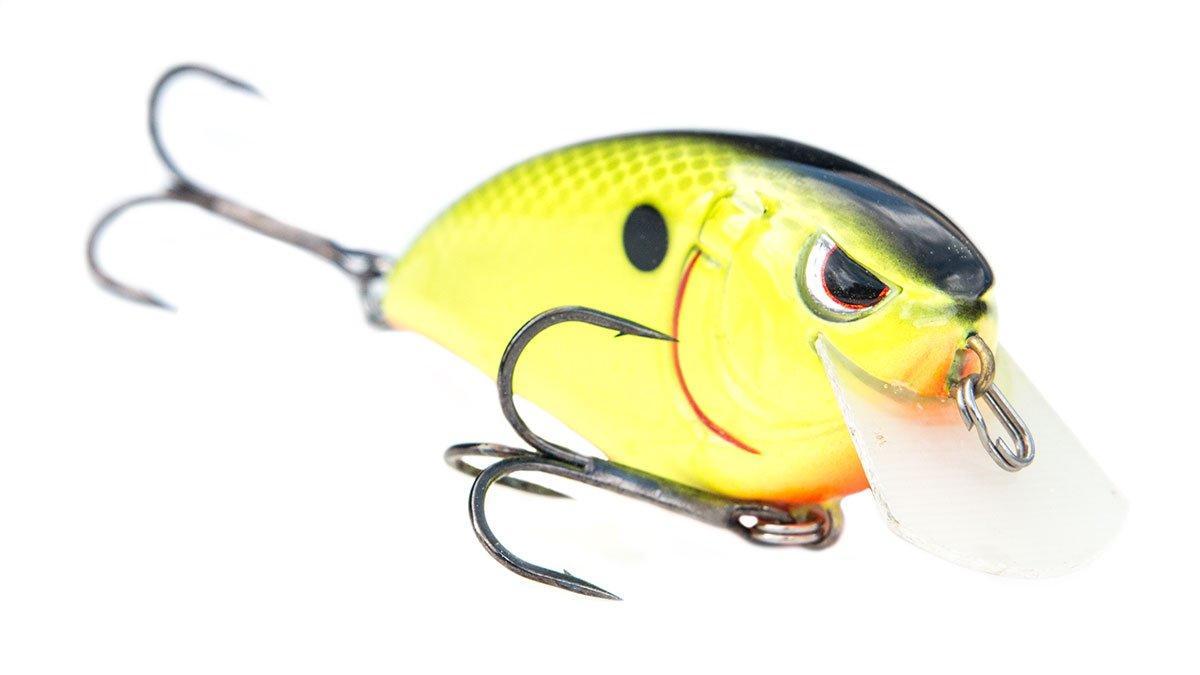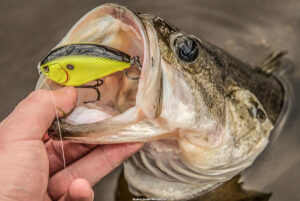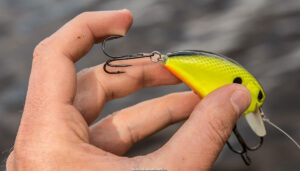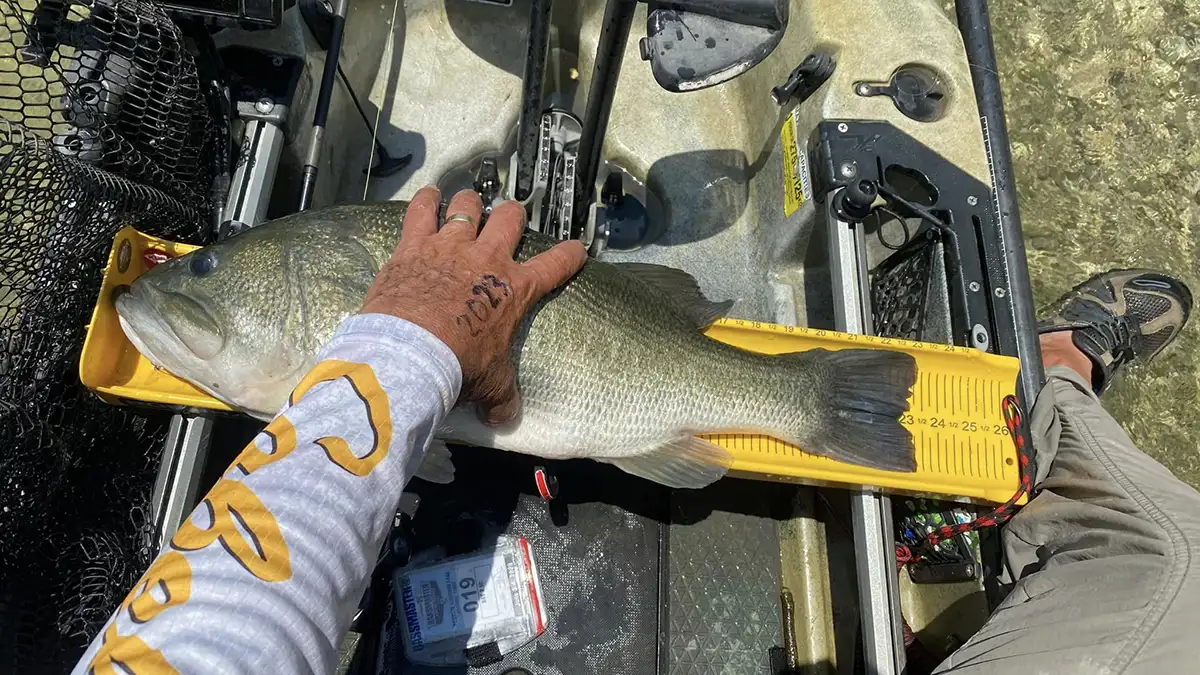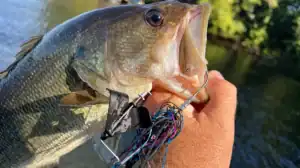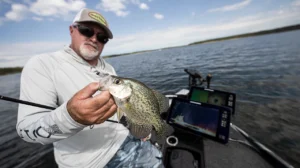Although I’ve been making a concerted effort in the past few years to improve my deep water fishing, I’ll admit—I’m always going to prefer crashing a crankbait into shallow cover. It’s been an addiction of mine since I was a young boy, which has allowed me to spend many years testing and studying the different design features of crankbaits. I’ve said it before and I’ll say it again; I’m a crankbait nerd and I’m darn proud of it.
One of my all-time favorite mass-produced crankbaits is SPRO’s Little John 50. That’s why you see it in a lot of my photos, videos and articles throughout the year. But lately I’ve been learning a lot and gaining a ton of confidence in its big brother, the SPRO Fat John 60.
This particular crankbait has several interesting aspects to it. I’ve spent a considerable amount of time fishing it on both large and small bodies of water with an excellent success rate. It’s not your run-of-the-mill squarebill, but it’s not neccessarily your traditional flat-sided plug, either. SPRO and John Crews have incorporated several features from each category in order to create a unique “hybrid”, of sorts.
In my opinion, there are several things bass anglers should know about this crankbait.
- It hunts throughout the retrieve
- Responsive to rod angles and retrieve speed
- No tweaking neccessary
- More durable than I expected
Great hunting action
In order to gain a better understanding of crankbaits, it’s important to pay close attention to a shad’s natural behavior. I’ve spent a lot of time with my arms crossed while I’m on my trolling motor, just watching schools of shad on the surface. What I’ve noticed is the reason why you will find very few crankbaits in my boat that run 100 percent straight.
Shad rarely swim in a straight line. Instead, they dart from side-to-side—that’s what bass are accustomed to seeing. It triggers their predatory instincts.
As a result, I prefer to use crankbaits that emulate this natural behavior. Yes, you want a crankbait that will run true without blowing out during the retrieve, but it’s also important to use a plug that has some sort of erratic behavior in the water. This is a fine balance that crankbait manufacturers have been trying to find for many years.
The SPRO Fat John 60 strikes this balance quite well. It features a circuit board lip and, while this component does make this lure a bit more expensive, its small amount of flex facilitates an excellent hunting action regardless of your preferred retrieve speed. Whether you’re crawling or burning this plug, it will intermittently kick to the side and quickly return to its center point. In other words, it doesn’t kick so much that it reduces your efficiency or productivity.
Exactly how much this lure hunts will depend largely upon your line selection. I primarily use 12 and 15-pound fluorocarbon when I’m shallow cranking, and the smaller diameter of 12-pound fluoro seems to give the Fat John 60 a bit more liberty to hunt throughout the retrieve—roughly 3 inches on average. When using 15-pound fluorocarbon around especially heavy cover or ultra-shallow water, this plug won’t hunt quite as much, but you’ll still notice a 1 to 2-inch deviation on a steady retrieve.
The Fat John 60 has also impressed me with its castability. It has an internal tungsten ball for added weight, but unlike the Little John 50, it’s stationary and located in the front of the plug. While I’m a big believer that the movement of the Little John 50’s internal tungsten ball creates a dull, yet very unique sound that capitalizes on a bass’ curiosity, I’m actually glad that SPRO decided to keep it stationary in the Fat John 60.
You’ll find some other shallow squarebills on the market with a free-floating—if you will—weight transfer system. But I’ve never been too crazy about them. When that plug collides with a piece of cover, these internal weights will often slide to the back of the lure and become stuck, which drastically affects its balance and deflection properties.
Responsive to rod angles and retrieve speed
This is something that I’ve become pretty picky about over the years. Common sense dictates that, the higher your rod tip and the slower your retrieve, the shallower a crankbait will run and vice versa. But for some odd reason, that’s not always the case.
The SPRO Fat John 60 was designed to run in the 1 to 3-foot range. That’s certainly it’s “sweet spot”, but depending upon your rod angle and retrieve speed, you’ll be able to expand its range considerably.
When I rig this crankbait on a 7-foot, medium-action casting rod with 12-pound fluorocarbon, I’ve been able to glance the bottom in rougly 4 1/2 feet of water and, on a rare occasion, 5 feet. Conversely, when used on a 7-foot, medium-heavy casting rod with 15-pound fluorocarbon, you can create a nice “waking” action on the surface, allowing you to quickly dissect extremely shallow water.
As far as deflection properties go, I wouldn’t consider this a crankbait you can cast into the middle of a bush without any snags. It’s definitely an all-terrain crankbait, but the rounded edge of its bill does present a few limitations, but if you’re a proficient shallow cranker, I don’t foresee you having any real issues with it.
Take it out of the package and go fishing
It’s always a major “plus” for me when I can fish a crankbait without making any modifications to it. Again, I’m picky with ‘em, so it’s becoming a rare occurrence for me these days. I’m happy to say, however, that fishing with the Fat John 60 has been fairly straightforward—remove it from the package, tie it on a cranking rod and go fishing.
Its hooks are exceptional, in my opinion.They’re No. 3 Gamakatsu trebles and they retain their sharpness quite well. If you’re crashing it into a bunch of cover, you can expect the hooks to remain sharp for several fishing trips. When I’m using this crankbait in a tournament situation, I’ll change the hooks a time or two throughout the day, but remember—I’m weird about that stuff. I’m sure it’s not really necessary, but old habits die hard.
It’s not wimpy
Crankbaits equipped with circuit board lips aren’t always known for their durability. Using this material instead of some sort of polymer often requires a bit of sacrifice—you’re going to give up a little durability in favor of more erratic action.
The Fat John 60 actually surprised me with its durability. When crankbaits are designed like this, the weakest point is often found at the connection point between the bill and the body. Sometimes you’ll notice cracking or separation in this area, but as of the time of this review, I haven’t had that issue.
The finish of this crankbait has also proven to be quite durable—more so than the Little John 50, actually. You’ll notice very little hook rash and a few teeth marks after some good afternoons on the water, but nothing major whatsoever. I haven’t experienced any chipping, cracking or spider webbing since using this lure.
Final impressions
I think the Fat John 60 is certainly worthy of consideration when making a purchasing decision. I’m sure some folks will bag on the price point, but I don’t see a problem with it. You’re getting a circuit board lip, premium split rings, awesome Gamakatsu hooks and a tungsten weight for $10.79. Everyone has different ideas of affordability, but after catching as many bass as I have with it, I’d honestly pay $15 for the thing.
All in all, it’s a solid crankbait that I really believe you’ll enjoy.
The SPRO Fat John 60 is available at TackleWarehouse.com.
